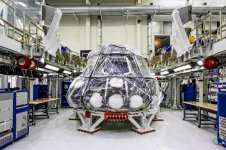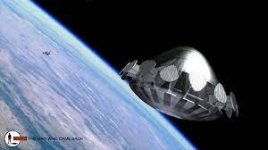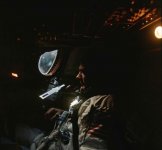Why is that?
The tangential speed of the earth's surface, with respect to is axis of rotation, decreases with increasing latitude.
We would normally launch near the equator to take advantage of the greater tangential speed at low latitude.
However, I read that high latitude launch sites are better suited for accessing polar orbits or highly elliptical orbits.
Highly elliptical orbits are now being used for communication satellites to cover the northern polar region that geocentric satellites can't service, and that will be the prime purpose of the Sutherland spaceport. https://en.wikipedia.org/wiki/Highly_elliptical_orbit
If you are launching to a high inclination, you actually have to take out all of the rotation of the location from which you launch, making it more difficult to achieve the orbit from near the equator.
Last edited:
Member
Joined 2009
Paid Member
Highly elliptical orbits must mean lots of Doppler shift in receiving/sending signal frequencies.
Why would that be? The HEO satellite would be moving slowly during its transmission window.
https://en.wikipedia.org/wiki/Highly_elliptical_orbit
https://en.wikipedia.org/wiki/Highly_elliptical_orbit
Northern launch sites: there is an outfit here in Maine (northerly USA) who thinks there is money in small launches. Their plan to takeoff from a field was denied. They are trying to get a barge approved. (Obviously they do not have Musk's leverage or balls.) Their other racket is a "bio" rocket fuel, undisclosed, but my bet is Allen's Coffee Brandy. (Not truly green, but tastes better than LOx.)
You DO want to defer big input until out of atmosphere. Just to stay away from Earth needs like 17,000 MPH (27,000 KPH). Do that in air and a LOT of irreversible air-drag. (As Bugun says: Earth-mount rail-guns suck.)
Bigun> They say that smaller rockets can be used to go from earth to moon - I don’t see why
I'm sure they mean: earth Orbit to moon. The hard part is reaching stable orbit. A little push from there and a long wait gets you anywhere.
http://www.projectrho.com/public_html/rocket/engines.php
In the sense that Kon Tiki traveled for "free".
You DO want to defer big input until out of atmosphere. Just to stay away from Earth needs like 17,000 MPH (27,000 KPH). Do that in air and a LOT of irreversible air-drag. (As Bugun says: Earth-mount rail-guns suck.)
Bigun> They say that smaller rockets can be used to go from earth to moon - I don’t see why
I'm sure they mean: earth Orbit to moon. The hard part is reaching stable orbit. A little push from there and a long wait gets you anywhere.
If you are just now discovering the basic tyranny, you are decades behind.took me to the Ideal Rocket Equation
http://www.projectrho.com/public_html/rocket/engines.php
<i>...everything is free...</i>
In the sense that Kon Tiki traveled for "free".
If you are just now discovering the basic tyranny, you are decades behind.
http://www.projectrho.com/public_html/rocket/engines.php
My knowledge of rocket science is about to take off, courtesy of your comprehensive link! 😎
I liked this simple statement which doesn't sound too much like rocket science:
"In order to calculate the spacecraft's total delta-V capacity, you need to know two things: the spacecraft's Mass Ratio, and the exhaust velocity of the engine. Surprisingly, you don't need to know anything else, not even the ship's mass."
The following table from the link shows the approximate cost in energy (in terms of velocity) to reach certain destinations.
| Destination | Energy Cost (km/s) |
|---|---|
| Surface of Earth to Earth orbit | 8 |
| Earth orbit to cis-lunar locations: Lagrange points | 3.5 |
| Earth orbit to cis-lunar locations: Low Lunar orbit | 4.1 |
| Earth orbit to near-Earth asteroids | > 4 |
| Earth orbit to surface Moon | 6 |
| Earth orbit to surface Mars | 8 |
The table clearly shows what we already know - that travelling from the surface of Earth to Earth orbit is one of the most energy intensive journeys in space.
And I love the illustrations:
And, in the movie Destination Moon, they expended too much propellent when landing ... and had to frantically reduce the structural mass of the ship!
Those are the four hold down arms that anchor the Saturn V to the pad till liftoff. The clamshell rotates to protect connections at the end of the arm from the fiery blast. The technology and requirements of the hold down arms are fascinating in themselves. All four must positively guarantee with 100 percent reliability release upon command, no matter what, within milliseconds of each other, and not one moment before.I recall seeing some ultra slo-mo footage of a Saturn Five launch, several cameras strategically placed around the base of the tower....I saw a clam-shell type blast shield device swinging closed to protect an apperant vulnerable piece of equipment in a direct path of the engine blast.
Pad structures seem to have differing values of survivability...no, we can build everything out of Inconel X-750.
------------------------------------------------------------------------------------------------------------------------------Rick...
On command surely means that these arms needed to be released just at the moment when the five J-1's total thrust exceeded the vehicle's actual mass, no?
Best regards!
Best regards!
Oops, to be more precisely: On command surely means that these arms needed to be released just at the moment when the five J-1's total thrust exceeded the vehicle's actual force of gravity, no?
Best regards!
Best regards!
Here's a photo take from the Orion spacecraft when it reached maximum distance from Earth yesterday.

The Orion capsule is crewed, not only by Snoopy, but also by three dummy astronauts, four Lego mini-figures and Shaun the Sheep!

The four Lego figures relate to a LEGO Education program meant to help teachers engage students in math, science, and engineering-related subjects.

Other items being carried aboard Orion include a moon rock from the Apollo 11 mission and a batch of tree seeds as a way of carrying on Apollo 14’s 'Moon Tree' legacy. http://www.highway199.org/history/apollo-14-moon-trees/#:~:text=The Siskiyou Smokejumper Base and the smokejumping experiences,to the moon during the Apollo space program.
The Orion capsule is crewed, not only by Snoopy, but also by three dummy astronauts, four Lego mini-figures and Shaun the Sheep!
The four Lego figures relate to a LEGO Education program meant to help teachers engage students in math, science, and engineering-related subjects.
Other items being carried aboard Orion include a moon rock from the Apollo 11 mission and a batch of tree seeds as a way of carrying on Apollo 14’s 'Moon Tree' legacy. http://www.highway199.org/history/apollo-14-moon-trees/#:~:text=The Siskiyou Smokejumper Base and the smokejumping experiences,to the moon during the Apollo space program.
Last edited:
Member
Joined 2009
Paid Member
Shaun really looks the part, where can I get one ?
It’s really cool to see an image of the moon and earth from that distance. Reminds me of an image at the end of one of my favourite sci fi shows.
It’s really cool to see an image of the moon and earth from that distance. Reminds me of an image at the end of one of my favourite sci fi shows.
Attachments
Last edited:
Reminds me of an image at the end of one of my favourite sci fi shows.
Could we be talking Thunderbirds or perhaps Fireball XL-5?
Member
Joined 2009
Paid Member
Derek Meddings certainly worked on Thunderbirds and Fireball XL-5, but your image comes from the UFO TV series.
I've got the complete works on DVD, but am more interested in the operatives than the UFOs! 😉

I've got the complete works on DVD, but am more interested in the operatives than the UFOs! 😉
On command surely means that these arms needed to be released just at the moment when the five J-1's total thrust exceeded the vehicle's actual mass, no?
Best regards!
My goodness! are those pressure suits?
say it ain't so! 😢
Don't forget that Neil Armstrong was there too:

https://www.forbes.com/sites/kionas...f-neil-armstrong-on-the-moon/?sh=3bd218847af0
A group picture:

Michael Collins also served. What an adventure! 😀
https://www.forbes.com/sites/kionas...f-neil-armstrong-on-the-moon/?sh=3bd218847af0
A group picture:
Michael Collins also served. What an adventure! 😀
- Home
- Member Areas
- The Lounge
- Artemis - the NASA mission




